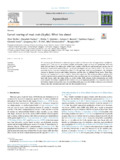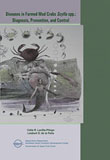Phenotypic differences between hatchery-reared and wild mud crabs, Scylla Serrata, and the effects of conditioning
| dc.contributor.author | Parkes, Lee | |
| dc.contributor.author | Quinitio, Emilia T. | |
| dc.contributor.author | Le Vay, Lewis | |
| dc.date.accessioned | 2014-06-23T02:52:59Z | |
| dc.date.available | 2014-06-23T02:52:59Z | |
| dc.date.issued | 2011 | |
| dc.identifier.citation | Parkes, L., Quinitio, E. T., & Le Vay, L. (2011). Phenotypic differences between hatchery-reared and wild mud crabs, Scylla Serrata, and the effects of conditioning. Aquaculture International, 19(2), 361-380. | en |
| dc.identifier.issn | 0967-6120 | |
| dc.identifier.uri | http://hdl.handle.net/10862/2117 | |
| dc.description.abstract | Hatchery-reared animals for stock enhancement should be competent to survive and grow at rates equivalent to those of wild conspecifics. However, morphological differences are often observed, and pre-conditioning steps may be required to improve the fitness of hatchery-reared juveniles prior to release. In the present study, hatchery-reared Scylla serrata juveniles were reared either individually (HR-solitary) or groups in tanks (HR-communal), the latter group being exposed to intraspecific competition and foraging for food. After 21 days, both groups were compared to similar size wild-caught juveniles in terms of morphometric measurements of carapace spination, abnormalities and carapace colouration. There were some limited significant differences between HR-communal crabs and HR-solitary crabs in terms of length of 8th and 9th lateral spines and in body-weight-carapace width ratio, but both treatments differed from wild crabs, which were heavier and had longer carapace spines for thei | |
| dc.description.abstract | Hatchery-reared animals for stock enhancement should be competent to survive and grow at rates equivalent to those of wild conspecifics. However, morphological differences are often observed, and pre-conditioning steps may be required to improve the fitness of hatchery-reared juveniles prior to release. In the present study, hatchery-reared Scylla serrata juveniles were reared either individually (HR-solitary) or groups in tanks (HR-communal), the latter group being exposed to intraspecific competition and foraging for food. After 21 days, both groups were compared to similar size wild-caught juveniles in terms of morphometric measurements of carapace spination, abnormalities and carapace colouration. There were some limited significant differences between HR-communal crabs and HR-solitary crabs in terms of length of 8th and 9th lateral spines and in body-weight-carapace width ratio, but both treatments differed from wild crabs, which were heavier and had longer carapace spines for their size. In contrast, both HR treatments exhibited common abnormalities including deformities in the shape of the abdomen, in particular occurrence of an asymmetrical telson or a deeply folded telson. In all cases, abnormalities persisted through moulting. Initially, carapace colour differed in all measures of colour between HR and wild crabs. However, these differences reduced after a period of 4–8 days of conditioning on coloured tank backgrounds or dark sand or mud backgrounds, without moulting. Similarly, hatchery-reared crabs exhibited very limited burying behaviour on first exposure to sediment, but this increased to levels observed in wild crabs within 2–4 days. Thus, short-term conditioning of hatchery-reared crabs on dark sediments may be effective in increasing predator avoidance and survivorship in released animals, and present results suggest that this can be achieved after relatively short periods of 1 week or less. | en |
| dc.description.sponsorship | This study was supported by a European Social Fund (ESF) grant to L. Parkes. The first author acknowledges the assistance of the SEAFDEC/AQD Crustacean Hatchery staff for the experimental set-up and animal husbandry and Dr. Fe Estepa for his help with the statistical analysis. | en |
| dc.language.iso | en | en |
| dc.publisher | Springer Verlag | en |
| dc.subject | Decapoda | en |
| dc.subject | Scylla serrata | en |
| dc.title | Phenotypic differences between hatchery-reared and wild mud crabs, Scylla Serrata, and the effects of conditioning | en |
| dc.type | Article | en |
| dc.identifier.doi | 10.1007/s10499-010-9372-1 | |
| dc.citation.volume | 19 | |
| dc.citation.issue | 2 | |
| dc.citation.spage | 361 | |
| dc.citation.epage | 380 | |
| dc.citation.journalTitle | Aquaculture International | en |
| dc.subject.asfa | malformations | en |
| dc.subject.asfa | aquaculture | en |
| dc.subject.asfa | avoidance reactions | en |
| dc.subject.asfa | bottom culture | en |
| dc.subject.asfa | burying | en |
| dc.subject.asfa | moulting | en |
| dc.subject.asfa | phenotypes | en |
| dc.subject.asfa | survival | en |
| dc.subject.asfa | telson | en |
| dc.identifier.essn | 1573-143X | |
| dc.subject.scientificName | Scylla serrata | en |
Files in this item
| Files | ขนาด | รูป | View |
|---|---|---|---|
|
There are no files associated with this item. |
|||
รายการนี้ปรากฏใน (s)
-
Journal Articles [1258]
These papers were contributed by Department staff to various national and international journals.



